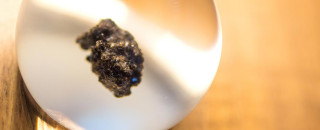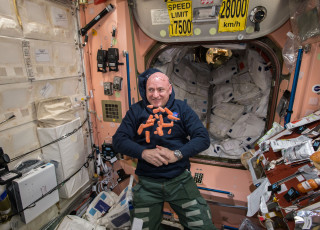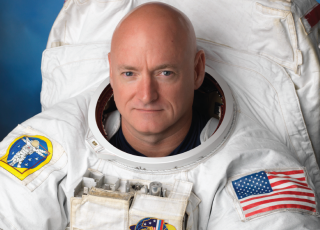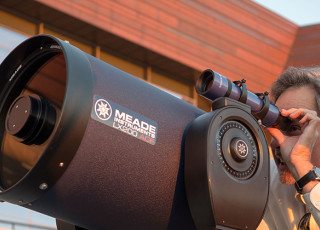A Piece of Goodwill: NHMU's Moon Rock
By Westin Porter
If you aren't looking for it, you might miss it: one of the Natural History Museum of Utah's oldest and farthest traveled objects.
It is about the size of a silver dollar, and about the same weight.
It is one of Utah's two Goodwill Moon Rocks. Our rock is approximately four-billion years old and it traveled approximately 240,000 miles from the moon to the Museum.
"The state of Utah has been presented two different fragments of moon rock... I see no reason why I cannot designate the Utah Museum of Natural History as the custodian of [one]," wrote then Utah Governor Calvin Rampton to then NHMU Director Donald Hague when the rocks were presented to the state in 1976.
This is how one of just a few hundred fragments of moon rock harvested by the last people to walk on the moon came to be displayed in a quiet corner of NHMU's Sky Gallery.
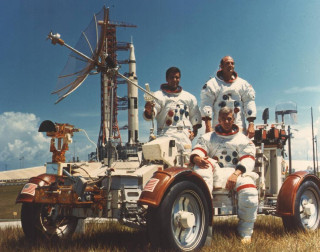
Schmitt, Evans, and Cernan are photographed with a Lunar Roving Vehicle trainer during the rollout of the Apollo 17 rocket. Photo credit: NASA
In 1972 NASA launched its final lunar mission in Apollo 17. The crew consisted of Commander Eugene Cernan and Pilots Harrison Schmitt and Ron Evans. With less than 24 hours on the moon's surface they were assigned to collect samples, take photos, and conduct several experiments including the "Traverse Gravimeter Experiment," which investigated the phenomenon of varying degrees of lunar gravity based on location.
Apollo 17 touched down in the Taurus-Littrow region--a valley between the Taurus mountain range and Littrow crater that was created by a meteoroid which collided with the moon nearly four-billion years ago. It was here that Cernan and his crew conducted their experiments and harvested what would be known as the Goodwill Moon Rocks.
The Goodwill Rocks were collected as symbols of unity to be gifted to people across the world. "To remind all the people of the world in so many countries throughout the world that this is what we all are striving for in the future," said Commander Cernan over the wire to NASA personnel listening back home. "It's a rock composed of many fragments of all sizes and shapes--and even colors--that have grown together to become a cohesive rock, outlasting the nature of space, sort of living together in a very coherent, very peaceful manner... We'd like to share a piece of this rock with so many of the countries throughout the world. We hope that this will be a symbol... that we can live in peace and harmony in the future."
The rocks were distributed to many nations as well as to every state in the U.S. While several other states' Goodwill Moon Rocks went missing or were stolen, Utah's have remained on display in the Utah State Capitol and at NHMU since their arrival. Cernan knew as his team concluded their mission and left the moon that it was likely humanity's last visit there, at least for a while. In the wake of those emotions, on a rock hurdling through space, furnished with gifts of good will, Cernan expounded upon a moment too big to comprehend.
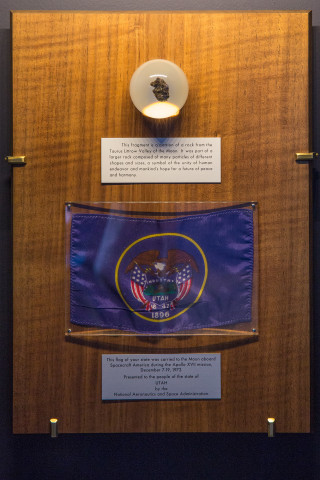
One of two Goodwill Moon Rocks at display in NHMU's Sky Gallery. ©NHMU
"As I take man's last step from the surface, back home for some time to come... I'd like to just [say] what I believe history will record. That America's challenge of today has forged man's destiny of tomorrow. And, as we leave the Moon at Taurus-Littrow, we leave as we came and, God willing, as we shall return, with peace and hope for all mankind."
Note: all quotes were sourced from NHMU records and NASA Lunar Surface Journal Transcriptions. Info on the Traverse Gravimeter Experiment was sourced from The Lunar and Planetary Institute.
Westin Porter is a Digital Science Writer for the Natural History Museum of Utah, a part of the University of Utah in Salt Lake City. Our mission is to illuminate the natural world and the place of humans within it. In addition to housing outstanding exhibits for the public, NHMU is a research museum. Learn more.
